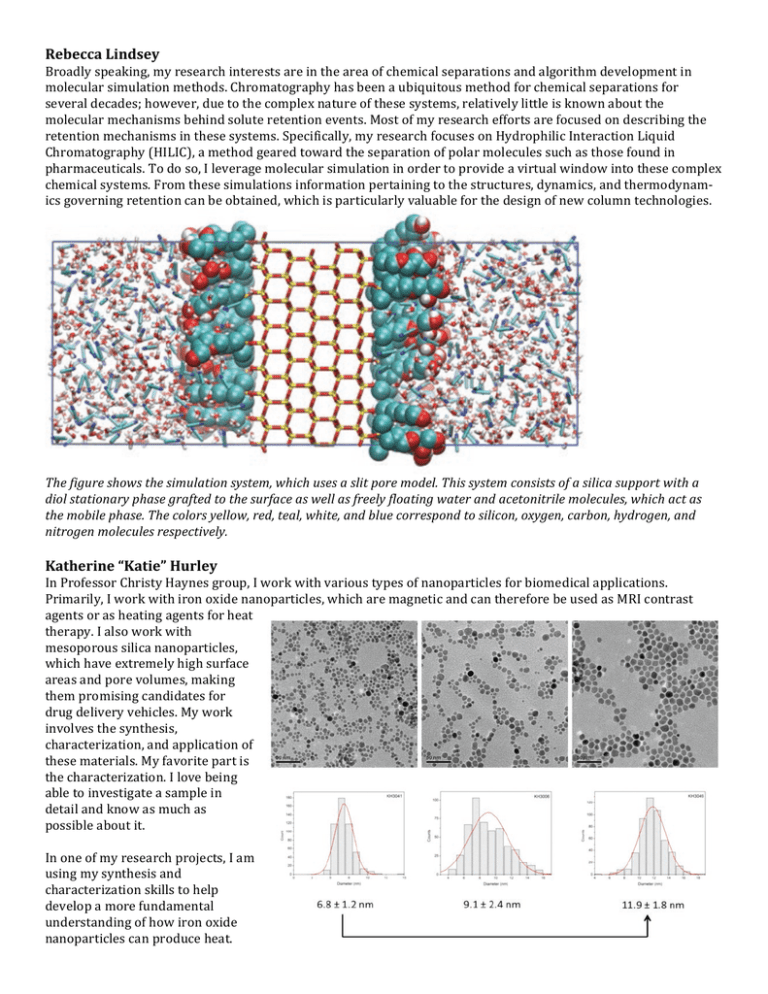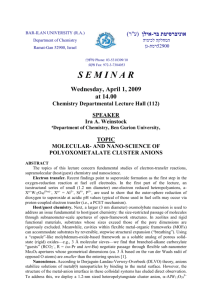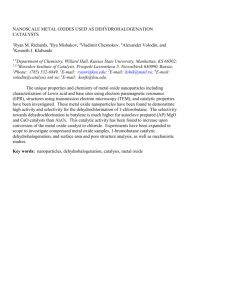Document 14204831
advertisement

Rebecca Lindsey Broadly speaking, my research interests are in the area of chemical separations and algorithm development in molecular simulation methods. Chromatography has been a ubiquitous method for chemical separations for several decades; however, due to the complex nature of these systems, relatively little is known about the molecular mechanisms behind solute retention events. Most of my research efforts are focused on describing the retention mechanisms in these systems. Specifically, my research focuses on Hydrophilic Interaction Liquid Chromatography (HILIC), a method geared toward the separation of polar molecules such as those found in pharmaceuticals. To do so, I leverage molecular simulation in order to provide a virtual window into these complex chemical systems. From these simulations information pertaining to the structures, dynamics, and thermodynam-­‐ ics governing retention can be obtained, which is particularly valuable for the design of new column technologies. The figure shows the simulation system, which uses a slit pore model. This system consists of a silica support with a diol stationary phase grafted to the surface as well as freely floating water and acetonitrile molecules, which act as the mobile phase. The colors yellow, red, teal, white, and blue correspond to silicon, oxygen, carbon, hydrogen, and nitrogen molecules respectively. Katherine “Katie” Hurley In Professor Christy Haynes group, I work with various types of nanoparticles for biomedical applications. Primarily, I work with iron oxide nanoparticles, which are magnetic and can therefore be used as MRI contrast agents or as heating agents for heat therapy. I also work with mesoporous silica nanoparticles, which have extremely high surface areas and pore volumes, making them promising candidates for drug delivery vehicles. My work involves the synthesis, characterization, and application of these materials. My favorite part is the characterization. I love being able to investigate a sample in detail and know as much as possible about it. In one of my research projects, I am using my synthesis and characterization skills to help develop a more fundamental understanding of how iron oxide nanoparticles can produce heat. When placed in an alternating magnetic field, magnetic nanoparticles like iron oxide will generate heat. The amount of heat generated seems to be related to specific material properties, but thus far there is no consensus regarding what parameters are the most important. All we know now is that particle anisotropy (shape, size, orientation of magnetic axis, etc.) plays a role. I am synthesizing monodisperse iron oxide nanoparticles of varying diameters with the same crystalline structure and coating, then working with a collaborator to determine their heating effectiveness. We hope to experimentally supplement a theory that claims there will be a large increase in heating ability at a certain diameter. Maria Miranda My research interests are focused on developing renewable materials using catalytic chemistry, and studying the mechanisms by which these catalysts operate. I have two major projects under this umbrella; one aims to understand the mechanism by which renewable cyclic ester monomers are polymerized into degradable polyesters using metal alkoxide catalysts, and the other is focused on using catalytic chemistry to synthesize high volume commodity monomers from renewable resources. For the second project, we utilized Pd precursors and phosphine ligands to decarbonylate (CO loss) plant-­‐derived carboxylic acids to terminal alkene monomers like styrene, alkyl acrylates and acrylonitrile. Synthesizing these alkene monomers from renewable resources is of key interest because traditionally these monomers are derived from petrochemicals. Our method has the advantage of being catalytic, neat (no solvent), high-­‐yielding (>80% yield), scalable (up to 50 g per batch) and robust (air, moisture, functional group tolerant). Paul “Alex” Rudd My research interests have centered on the modular synthesis of metal-­‐metal bonds, including electronic structure and reactivity. In addition to my current research projects, I’m also quite interested in chemistry of f-­‐block elements, especially uranium. William “Bill” Evans gave a seminar here a few years ago regarding how to blaze a new trail in science, and new f-­‐block chemistry of the last few years has vindicated his belief that new, unexpected, and useful chemistry would come out of these elements. If I could start a new project tomorrow, it would involve the coordination of chemistry and reactivity of uranium complexes! My research projects all involve the systematic synthesis and study of metal-­‐metal bonds: our fundamental goal is to be able to predict the properties of a metal-­‐metal bond before we make it. With that knowledge in hand, we hope to be able to predict what types of chemical reactions different metal-­‐metal bonds can facilitate, ultimately offering a rational tool to help guide the study of reactive transition metal complexes. In this vein, one of my current projects involves the reduction of dinitrogen at an iron center. Biological nitrogen fixation occurs at a multi-­‐iron site at room temperature, but homogenous chemistry has been largely unable to replicate this impressive feat, which requires a six-­‐electron reduction of dinitrogen to generate two ammonia molecules. We have previously demonstrated the partial reduction of dinitrogen with an iron-­‐aluminum complex, which is capable of breaking the strong double and triple bonds of the typically inert dinitrogen triple bond with only a single iron center. Current research efforts are focused on the final two-­‐electron step, which we believe is accessible, that is required to cleave the remaining single bond in this complex. Complementary efforts are underway to synthesize iron complexes with other group thirteen elements (i.e., B, Ga, In) to quantitatively determine the influence of the second metal center. Stephen Rudisill The research I’m interested in uses clever, simple chemistry to add controlled shapes to the nanoscience toolbox. From a technical perspective, I’m interested in the self-­‐assembly of complex, nano-­‐to-­‐micrometer sized shaped materials through templating, modifying colloidal electrostatics, and directing crystal growth, among other methods. I’m also invested in finding uses for these shaped materials, particularly in the alternative energy and catalysis fields. My main research project now is on self-­‐assembly of three-­‐dimensionally ordered macroporous (3DOM) microspheres and bicontinuous networks from metal-­‐polyester precursors. 3DOM materials are a staple of Professor Andreas Stein’s research, these are produced by forming an ordered array or “colloidal crystal” of 300-­‐ 500 nm poly(methyl methacrylate) spheres, filling the spaces between the spheres with a precursor, and then burning the spheres and crystalizing the precursor at high temperature. Formation of spheres with the 3DOM structure can be a bit tricky. The technique relies on the phase separation that occurs between a growing polymer in solution and the solvent (in this case, water), as a result of the growing polarity difference between the two phases. The extent of that polarity difference changes the amount of interfacial area between the polymer and the water, which results in different shapes—either microspheres, or a bicontinuous network. The polarity difference is almost solely dependent on the molecular weight of the polymer; the higher molecular weight, the more non-­‐polar the polymer phase will be. So, by controlling the extent of polymerization, we can change the morphology of the material, as well as the size of the features. We primarily control this polymerization by changing the reagent imbalance between the ethylene glycol and citric acid, which make up the polymer. In the March 12 cover article of Chemistry of Materials, we demonstrated the effectiveness of this technique for a common catalytic oxide, CeO2. Before this discovery, polymerization-­‐induced phase separation could be performed with a limited set of materials (silica, zirconia, titania), and required specialty precursors known as alkoxides. The technique here utilizes cheap, widely available reagents and, in theory, can be used with any element on the periodic table which forms a nitrate salt. Future goals in this project are to demonstrate exactly that, and provide a roadmap for generalizing the technique. In the process, we have whole new batch of technical issues to overcome, given the substantial differences between size, charge, and reactivity of the ions we’re investigating.




